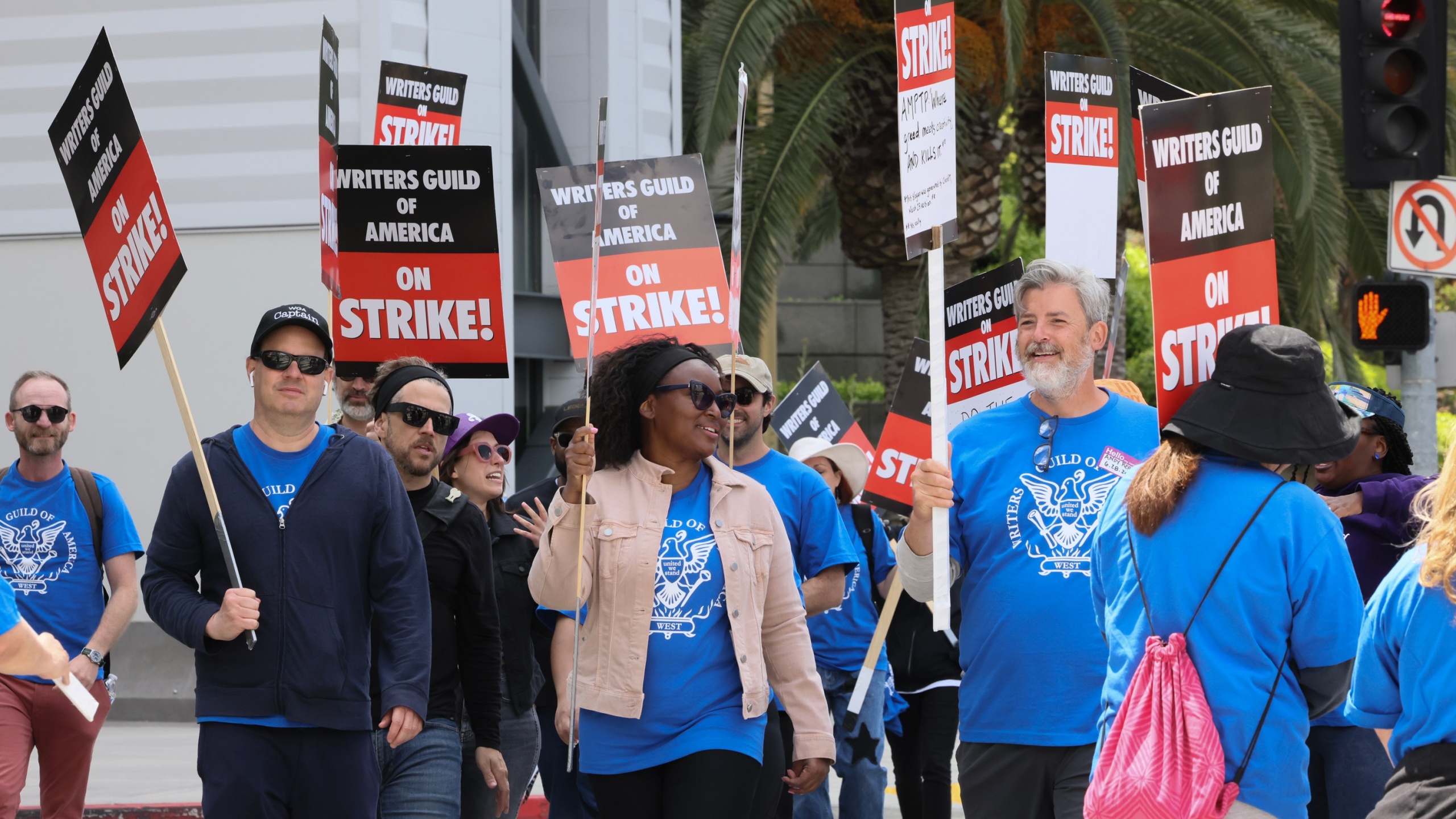The ongoing Writers Guild of America strike, which brought Hollywood to a screeching halt in May, comes at a once-in-a-generation inflection point for the entertainment industry.
A decade of changes in viewing habits has resulted in a consumer base that wants to watch more content, but pay for less of it — and do so primarily on their own schedules without leaving the house. Hollywood’s pivot to streaming created a brief gold rush as legacy brands attempted to build up these subscriber bases with massive quantities of content. But the past year has slowly seen studios and networks come to the collective realization that their business model isn’t viable as it stands.
The artists who actually make the content that fuels the Streaming Wars face an equally frustrating predicament. Streaming may have created more jobs in the short term, but it has eroded the residuals that once formed the bedrock of a writer’s income. Screenwriters are working more, earning less, and being asked to come to terms with the idea that their work can be removed from streaming circulation at any moment — and for any reason. The WGA went on strike with the intention of not just securing more resources for its members, but reaching a new understanding about the ways in which studios and artists can coexist in this unfamiliar and fraught era.
In some ways, the current situation is unprecedented. But the story of Hollywood writers striking when technological innovations threaten their established income sources is not new. The WGA has gone on strike eight times since forming in 1933, most recently in 2007. Many of the strikes were tied to emerging technologies that threatened to fundamentally alter the way Hollywood distributes entertainment — and were ultimately resolved once the guild felt that writers had been assured an appropriately-sized slice of the new pie.
Anyone looking for clarity about the current ambiguity facing Hollywood would be well advised to study the history of writers strikes. While streaming profitability (or the lack thereof) and artificial intelligence are uniquely 21st century problems, many of the previous strikes unfolded in similar ways. Keep reading for a chronological history of WGA strikes, including the ways that Hollywood resolved the first seven work stoppages — running alongside photos of the current actions still playing out in New York and Los Angeles.
-
1952 (August – November, 14 weeks)

Image Credit: Spencer Platt/Getty Images What was at stake: The very concept of residuals. The Screen Writers Guild — which would later split and become the bifurcated east/west coast Writers Guild of America in 1954 — joined powers with the Authors League of America two years earlier to demand royalties (later known as residuals) and secure better ownership over their work. The unions went on strike against the Alliance of Television Film Producers for 14 weeks, and fought for residuals based on a percentage of overall project earnings; as well as to retain rights to their work in an evolving landscape of reruns, remakes, and sequels.
What was the outcome: The agreement that ended the 1952 strike gave writers unprecedented ownership over their stories and scripts; in some instances, capping studio ownership of writers’ work (renewal notwithstanding). Together, the two unions made history by establishing residuals for TV writers. But they were forced to concede to a percentage of the original price paid: a flat-fee not adjusted for project success. —AF
-
1960 (January – June, 21 weeks)

Image Credit: David McNew/Getty Images What was at stake: Employment benefits, and residuals for theatrical projects rereleased on TV. At the same time that Ronald Reagan was leading the 1960 Screen Actors Guild strike, the WGA went up against the ATFP for a second time on pay — this time focusing on the pipeline from theaterical showings to televised reruns. The union also sought better job benefits for writers, proposing independent pension and health care plans.
What was the outcome: The WGA won residuals for films rereleased on television, as well as established a writers’ pension fund. Studios also agreed to participation in an industry health care system. —AF
-
1973 (March – June, 16 weeks)

Image Credit: Rodin Eckenroth/Getty Images What was at stake: Compensation from the still-emerging home video market. VHS players weren’t even in homes when the WGA struck the Association of Motion Picture and Television Producers over the emerging technology in 1973. Writers demanded compensation for video cassettes and paid TV in the first of numerous WGA actions about the distribution issues of this era.
What was the outcome: The writers successfully secured residuals on video cassettes and paid television, as well as established an independent health fund for the guild and set up incremental salary increases for writers on longer projects. —AF
-
1981 (April – July, 13 weeks)

Image Credit: Spencer Platt/Getty Images What was at stake: Everything the 1973 strike predicted. Actors walked off the job in the summer of 1980, when SAG and AFTRA combined forced to demands performers receive increased pay and a better kickback from video cassettes and paid television. Those same issues would inspire the WGA to strike for 13 weeks the following year, with a focus on residuals from cable television.
What was the outcome: The cascading industry walkoffs between 1980 and 1981 significantly delayed television. And while the WGA secured some of what it sought (with a fixed percentage of the distributor’s gross earnings from rereuns going to writers), the 1981 strike would portend a decade of back-and-forth between writers and studios. —AF
-
1985 (March 5 – 19, 2 weeks)

Image Credit: David McNew/Getty Images What was at stake: As Hollywood began to wrap its arms around the windfall created by home video sales, writers went on strike in an attempt to obtain a larger percentage of the profits. The key dispute revolved around where the money was coming from: a film’s screenwriters typically received a percentage of producers’ royalties, but the guild went on strike in an attempt to wet its beak from the much larger pool of VHS revenue that distributors received.
What was the outcome: The strike was resolved within two weeks, with the WGA quickly agreeing to drop the VHS issue in favor of a fairly standard 6% raise in wages and increased health benefits. The controversial outcome was seen by many as a Band-Aid on a larger dispute that remained unsolved. —CZ
-
1988 (March – August, 22 weeks)

Image Credit: Michael M. Santiago/Getty Images What was at stake: When the three year collective bargaining agreement reached in 1985 expired, the WGA embarked on a strike aimed at securing larger residuals for syndicated television shows. Growing domestic and international markets created new demand for reruns of existing shows, but studios compensated writers via a percentage-based system that many felt was susceptible to dishonest accounting practices. The guild sought to replace the sliding scale with a fixed method of compensation.
What was the outcome: The strike lasted from March 7 through August 7 and resulted in $500 million in lost revenue for studios. Writers and studios eventually compromised on syndication royalties, with the percentage-based compensation system remaining in place while writers received higher fees for reruns in international markets. The four year deal also gave new creative protections to writers who sold original film scripts. However, the strike was credited with significantly decreasing TV audiences, as many popular shows were unable to rebuild fan enthusiasm after long hiatuses. —CZ
-
2007-08 (November – February, 14 weeks)

Image Credit: Rodin Eckenroth/Getty Images What was at stake: Revenue from the internet. While streaming was still in its infancy 2007 — Netflix launched its online viewing platform less than a year before the WGA strike — writers and studios were beginning to fight about profits from the next frontier in film distribution. Savvy writers also saw the writing on the wall about the direct-to-streaming content that would eventually be produced, and sought to have standard union rules followed on what was then referred to as “new media.”
What was the outcome: After a 100 day strike that lasted from November 2007 to February 2008, the WGA and AMPTP laid the groundwork for the existing Internet distribution landscape. The new collective bargaining agreement found a mutually acceptable revenue sharing system for online movie rentals and ad-supported streaming of existing shows on network websites. More importantly, the union gained jurisdiction over shows produced for streaming services, ensuring that Netflix and Amazon original series followed the same production and compensation procedures as shows on cable. —CZ
-
2023 (May – present)

Image Credit: Michael M. Santiago/Getty Images What was at stake: The viability of TV writing as a career in the streaming age. With royalties dwindling, artificial intelligence threatening to replace (or at least supplement) human writers, and streaming services rapidly purging their content libraries and occasionally preventing completed projects from being released, the WGA launched a strike with the hope of creating a “new normal” that would allow writers to continue to earn a living. Many expected the strike to be tied to similar work stoppages from Hollywood directors and actors, but the Directors Guild of America recently reached a new deal to avert a strike. SAG-AFTRA has until June 30 to reach a deal of its own before actors begin striking.
What was the outcome: The Writers Guild of America authorized a strike on May 3, 2023. As of this writing, it has yet to be resolved. Virtually all major TV series have halted production — some attempted to continue shooting with scripts written before the strike, but complications involving producing duties performed by WGA members rendered that virtually impossible. —CZ


